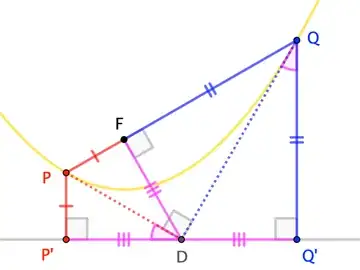I am trying to determine the equation of directrix and focus of the parabola which has tangents $y=x$ at $(3,3)$ and $y=-x$ at $(1,-1)$. Drawing a rough picture suggest that the parabola is oblique. Also since the foot of perpendicular from focus to any tangent lies on the tangent at vertex, this implies that the line joining the focus and the foot of perpendicular to tangent $y=x$ is of the form $x+y=k_1, k_1\in\mathbb{R}$ and also line joining focus and foot of perpendicular to tangent $y=-x$ is of the form $y=x+k_2,k_2\in\mathbb{R}$.
One standard method is to consider $ax^2+by^2+2gx+2fy+2hxy+c=0$ and write the equation of tangents with point of contact $(x_1,y_1)$ as $axx_1+byy_1+g(x+x_1)+f(y+y_1)+h(x_1y+xy_1)+c=0$ for both the tangents and compare with the equation of tangents but that is rather tedious.
It is unclear on how to proceed from here. Any hints involving only the geometry of the standard parabola without involvement of linear algebra techniques are appreciated. Thanks.
